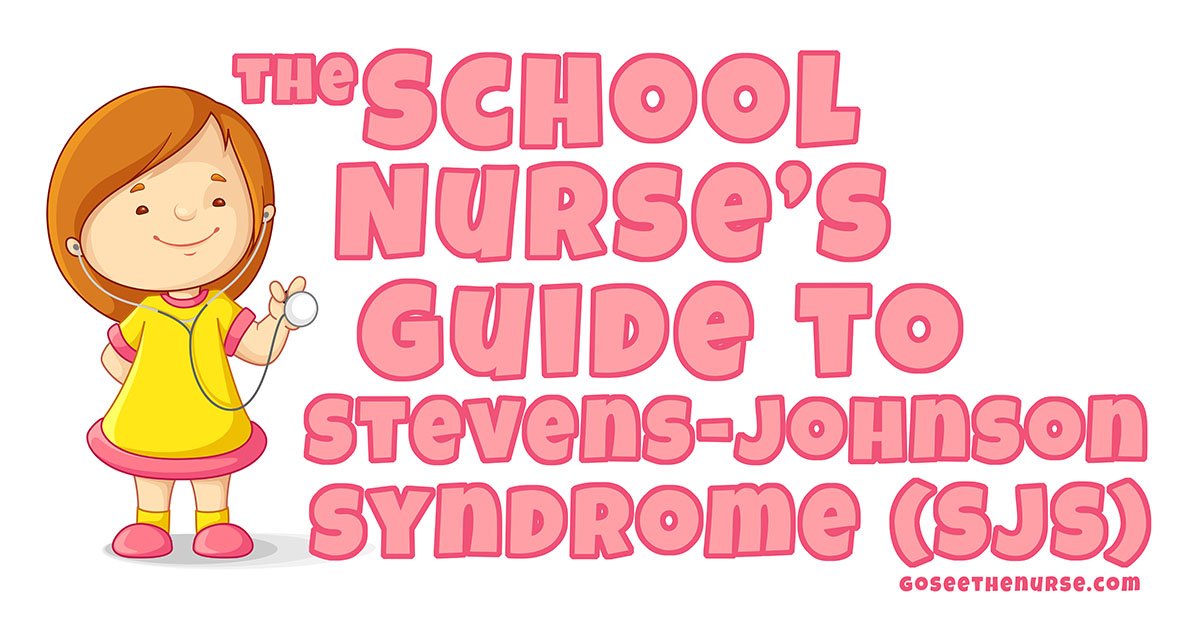
School Nurse Guide to Stevens-Johnson Syndrome
A couple of articles ago, I wrote about “grey gorilla nurses” and how every nursing “arena” needs these been-there-and-done-that kinda of nurses. We have a couple or three of those awesome school nurses at our district. Having spent 10+ years in hospice, I was one that received the calls from fellow hospice nurses asking this-and-that. Now, as a school nurse of 4 years, I sorta had to start over and joint the ranks of the greenies. I quickly learned who the grey gorilla school nurses were and made nicey-nice (Yea! I’m talking about you, and YEAH! I still need your advice...and if you retire...I’ll call you at home...and, no...what you just said ain’t appropriate in the school house.)
So, here I am with a child and a massive rash. My grey gorilla school nurse suggested that I keep my eye on this kiddo and watch for Henoch-Schönlein purpura (last week) and another condition called Stevens-Johnson syndrome.
What is Stevens-Johnson syndrome?
Stevens-Johnson syndrome (SJS) is a rare (about 3 or so per million) yet very severe reaction commonly triggered by medications like antibiotics. Basically, what happens during Stevens-Johnson syndrome (SJS) is the skin will literally die and detach (cutaneous reaction). Commonly, the mucous membranes are affected as well. And, when the mucus membranes of the eyes, mouth, and genitals are affected, folks get real unhappy real quick.
These days, the medical community considers Stevens-Johnson syndrome (SJS) and toxic epidermal necrolysis (TEN) as a being the same condition, yet SJS is the “condition” seen earlier in the spectrum of disease and TEN is found later during the disease’s spectrum. Please don’t get me wrong. There ain’t nothin’ “mild” about Stevens-Johnson syndrome (SJS). In this article, we’ll be talking about Stevens-Johnson syndrome (SJS) with the idea that if we are assessing for Stevens-Johnson syndrome (SJS), we’ll also be assessing for toxic epidermal necrolysis (TEN).
https://www.cdc.gov/ophss/csels/dsepd/ss1978/lesson1/section9.html
The Role of the School Nurse and Stevens-Johnson syndrome
Where do we school nurses come in at with a child who may be suffering from Stevens-Johnson syndrome?
There are many causes of SJS ranging from having a genetic predisposition to environmental factors to a medication reaction. Most all SJS cases are a reaction to a medication. What happens here is the child may start to experience flu-like illness (fever, cough, and headache) about 1-3 weeks after starting a medication...and during a time when they should start feeling better. After these flu-like symptoms present, the telltale symptoms will begin to present with the rash forming first, followed by peeling skin. Likely, the rash will be enough to send the child for advanced medical care BEFORE you, the school nurse, are able to witness the peeling skin.
Because SJS involves the mucus membranes as well as the outer dermis, you may pay close attention to lips that appear severely and persistently chapped-looking as well as painful urination / painful swallowing / mouth sores. Sure, we school nurses see children all the time for chapped lips and sometimes for “it hurts when I pee.” But these findings, along with a recent history of missing days from school because of an illness like strep throat (or any other illness) and being on or having completed a round of antibiotics, may cause your nursey-senses to tingle a bit more followed by a call home to mamma or daddy to make them aware.
Making parents aware of findings is one thing. However, if you see a child with painful red or purple skin that looks burned; blisters on their skin, mouth, or nose; complaining of issues with their privates (genitals); red, painful, and/or watery eyes, this child needs to be gathered and the parent strongly encouraged to take the child to the emergency room. Of course you will not see all of these symptoms all at once on a child in your school house; the child would have long since been taken to the ER. But, if you have any of these findings along with a history of an illness followed by a medication like an antibiotic then followed by flu-like symptoms then followed by any of these symptoms, the child needs to be seen by a physician.
Treatments for Stevens-Johnson syndrome
As a school nurse, you may...MAY...see the very initial findings of SJS. This is a very serious condition that requires hospitalization. Folks with SJS usually are admitted to burn unit or ICU. That makes sense, right? Peeling and blistering skin even from the inside out is still peeling and blistering skin and the treatment would be similar to those having suffered burns. A child with this condition will not be in school.
More Thoughts about Stevens-Johnson syndrome
Other names for SJS are:
- Lyell’s syndrome
- Stevens-Johnson syndrome
- Toxic epidermal necrolysis
- Stevens-Johnson syndrome toxic epidermal necrolysis spectrum.
- Drug-induced Stevens-Johnson syndrome (depending on the cause)
- Mycoplasma-induced Stevens-Johnson syndrome
Unlike Henoch-Schonlein purpura, SJS is more common in females than males.
More than 100 drugs can cause SJS. For us school nurses, be aware that common drugs can cause SJS including acetaminophen (Tylenol), ibuprofen (Advil, Motrin), naproxen (Aleve), antibiotics, seizure medications, and drugs that treat mental illnesses.
More than likely, if a kiddo is going to develop SJS as a result from a reaction from a drug, it will happen within the first 2 months of their taking a drug.
The rash does not usually itch.
Rash will spread in hours and sometimes over days.
A risk factor for Stevens-Johnson syndrome is a weakened immune system (pay close attention to that child being treated for cancer or the child with HIV).
We school nurses may not do an extensive assessment of a family history. However, if you learn that a child has a family history of SJS, pay close attention to that child if they are ever ill or have been put on a new medication.
Once the culprit is identified (the illness or medication) and resolved or discontinued, the child should begin to heal. However, full resolution of the condition depends on how severe the condition became. It could take weeks or even months to resolve. Your team at your school may have to make special arrangements in order to meet the child’s educational needs during the healing process. (https://www.nhs.uk/conditions/stevens-johnson-syndrome/)
https://accesspediatrics.mhmedical.com/content.aspx?bookid=1443§ionid=79846569
https://my.clevelandclinic.org/health/diseases/17656-stevens-johnson-syndrome
https://www.nhs.uk/conditions/stevens-johnson-syndrome/
https://www.webmd.com/skin-problems-and-treatments/stevens-johnson-syndrome#1

The happy eggs gets the updates from Go See The Nurse! Start getting (non-spammy) updates from Nurse Kevin!
Your information is kept private! Here's my Privacy Statement.
Nurse Kevin



